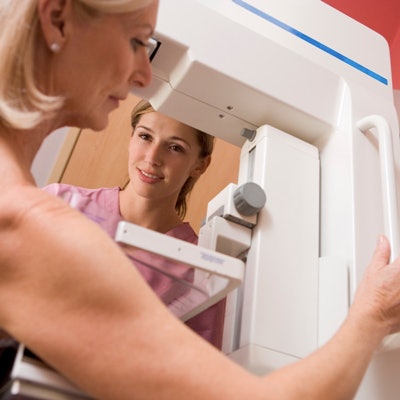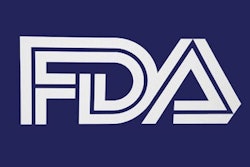
Radiologists remain conflicted about breast density notification legislation, whether to recommend supplemental imaging for women with dense breast tissue, and, if so, what kind of imaging is best, according to a study published in the October edition of Academic Radiology.
A team led by Dr. Ana Lourenco at Brown University found that only 66% of respondents to a survey of members of the New England Roentgen Ray Society felt that density notification legislation increased provider awareness about density's effect on mammographic sensitivity. Survey respondents also did not agree on which adjunctive screening modality to recommend for average-risk women with dense tissue: More than half favored digital breast tomosynthesis (DBT), while more than a quarter favored ultrasound.
"There is a clear need for both more data and more professional guidelines that can help inform practicing physicians and patients," the group wrote. "Our study confirms that radiologists would benefit from further education about breast density laws, the clinical importance of dense breast tissue, and management of women with dense tissue."
Persistent confusion
Why the persistent confusion? Determining breast density can be subjective and variable, even with automated software programs, Lourenco and colleagues wrote. For women with dense tissue who have more than a 20% lifetime risk for breast cancer, adjunctive breast MRI is recommended. However, for women with dense tissue at average or intermediate lifetime risk for the disease, there is no consensus or professional guideline regarding additional imaging. Insurance coverage for additional imaging is variable as well (Acad Radiol, October 2017, Vol. 24:10, pp. 1265-1267).
 Dr. Ana Lourenco from Brown University.
Dr. Ana Lourenco from Brown University."There aren't strong professional guidelines to help referring providers determine whether to send patients for additional imaging, and what kind of imaging is best for women at average risk," Lourenco told AuntMinnie.com. "And the average general radiologist reading mammograms often remains confused about how big a risk factor breast density actually is -- and therefore what to recommend in terms of supplemental studies."
To assess radiologists' knowledge about breast density legislation and any practice changes in response to it, Lourenco and colleagues in February 2016 invited the 523 members of the New England Roentgen Ray Society to complete a 29-question survey via email.
Of the 523 members, 96 responded; 73% of the respondents practiced in a state with breast density legislation. Most (69%) felt that breast density notification legislation increased women's anxiety about breast cancer. In addition, 74% believed that it increased patient understanding of the effect of breast density on mammography's sensitivity, while 66% believed that it increased referring provider understanding of density's effect on mammography.
Regarding the best approach to determining whether a woman with dense breast tissue would benefit from additional screening, 44% of survey participants suggested risk assessment at the time of imaging, and 32% were unsure. Almost half (49%) stated that risk assessment was not offered in their practice.
In terms of what type of supplemental imaging was most effective, most respondents said that for women with heterogeneously dense breasts, both digital mammography (80 respondents) and DBT (79 respondents) were useful. For women with extremely dense breasts, most survey participants again felt that both digital mammography (73 respondents) and DBT (70 respondents) were useful.
For women at high risk, 72% of survey respondents said breast MRI was the best supplemental screening tool; for women at average risk, 53% felt that DBT was the best tool and 26% said ultrasound was most effective, the researchers found.
Finally, when it came to accurate understanding of the relative risk of breast cancer -- comparing a woman with heterogeneously dense tissue to a woman with average breast tissue density -- 63% of survey respondents correctly answered that a woman with heterogeneously dense tissue has 1.2 times the risk of her average-tissue counterpart. When comparing women with extremely dense tissue to those with average breast density, 55% of survey participants correctly answered that women with extremely dense tissue have 2.1 times the risk of their average-tissue counterparts. But only 38% of survey respondents knew that women with extremely dense tissue have four to six times the risk of cancer compared to women with fatty tissue.
Although the cohort was small and confined to a particular geographic area, study results can likely be extrapolated beyond New England, according to the researchers.
"The respondents in this study ... reflect a 'real-world' cross section of radiologists, as most were in private practice, were not fellowship trained in breast imaging, and spent 50% or less of their time doing breast imaging," the team wrote. "This is in keeping with known workforce data, as private practice radiology positions outnumber academic positions, and most breast imaging studies are interpreted by general radiologists."
Professional guidance
So what could mitigate this confusion regarding how to screen women with dense breast tissue? A professional society guideline would be very helpful for both referring physicians and radiologists -- and the American College of Radiology (ACR) is working on it, Lourenco said. The college released a position statement on breast density reporting in 2012, and it has also published a patient resource regarding tissue density.
"A guideline from the ACR is forthcoming and will include more discussion of ultrasound's role in supplemental screening," she said.
How to evaluate breast density and how to track women who have dense tissue continues to be a work in progress, Lourenco and colleagues wrote.
"Breast density is an established risk factor for breast cancer, but it is important to keep this risk factor in perspective when recommending additional screening," they concluded. "For radiologists to be effective consultants to primary care providers and patients in this era of dense breast legislation, [they need] additional educational material."



















